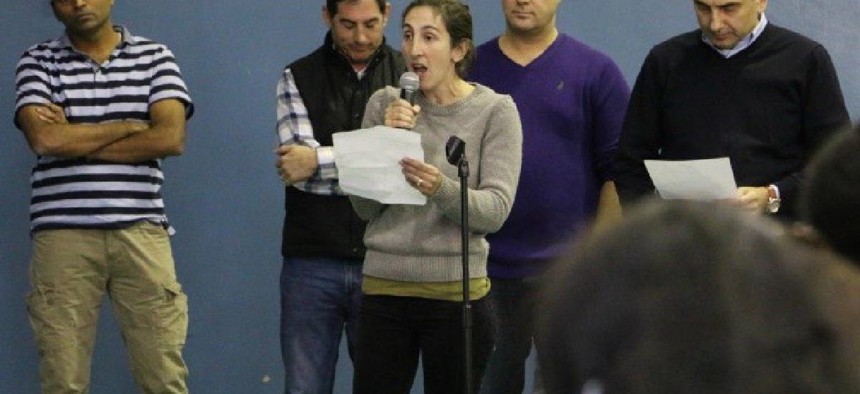This article was first published by Chalkbeat New York on March 1.
On the Upper West Side and in southern Harlem, like in most parts of New York City, students are matched with an elementary school based on their address. While that system lets students attend school close to home, it also can also reproduce a community’s housing segregation in its schools.
But some parents and educators in Manhattan’s District 3 have a bold plan to fix that: They want to erase the zone lines around those schools, letting parents apply to anywhere in the district. Then a computer algorithm would match students with schools by factoring in their choices, but also their demographics, so that students from different backgrounds are spread evenly across the district.
But the prospect of District 3 adopting a controlled choice system anytime soon appears slim.
Families who live near one of the district’s highest-performing schools recently lashed out at a proposal to alter its zone, and families at other top district schools would most likely oppose any plan to abolish the zones that guarantee them spots in those schools. Meanwhile, several members of the CEC, which must approve zoning changes, have expressed skepticism about controlled choice.
Theresa Hammonds, a CEC member, said she has recently started to question whether a different enrollment system would be enough to integrate some schools, even though she was part of the parent group that drew up a controlled-choice plan for the district.
“If a family perceives a school across the street to lack quality because of test scores,” she said, “it doesn’t matter what kind of choice system you have in place, the family’s not going to send their child to that school.”
District 3, which is home to luxury high-rise buildings alongside public housing developments, is filled with students from a mix of backgrounds, and yet many of its schools are largely divided along race and class lines. While the district is 36 percent white, a number of schools are more than 90 percent black and Hispanic.
That segregation came into sharp focus this fall when the city proposed redrawing the zone lines around P.S. 199, a sought-after school on West 70th Street with outstanding test scores and a student body that is two-thirds white and only 8 percent poor. The rezoning would have shifted some would-be 199 parents to P.S. 191, a low-performing school just nine blocks away, whose student population is 85 percent black and Hispanic and primarily low-income.
Following fierce resistance from families in P.S. 199’s zone, the city agreed to table that proposal. Now, parent leaders on the CEC are working with education department planners to come up with new ways to alleviate the intense overcrowding at popular P.S. 199, while perhaps also boosting diversity in the district.
Parents have come up with at least two proposals. One would create a single zone around P.S. 191 and 199, while the second plan would have students attend one school for the early grades and the other for subsequent grades.
However, P.S. 199 parents and faculty members have rejected both plans, according to CEC members and minutes of CEC meetings.
“There’s still significant pushback from parts of the 199 community,” said CEC member Noah Gotbaum, who has championed the shared-zone plan.
A more radical option would be to scrap the zones entirely and adopt a controlled-choice admissions system.
That’s the plan promoted by the District 3 Task Force for Equity in Education, a small group of parents and educators that has been searching for solutions to the district’s divisions and disparities since 2012. This past December, the parent association and school leadership team at P.S. 75 wrote the CEC asking it to explore a controlled-choice system for the district.
Ujju Aggarwal, a task force member and researcher at the CUNY Graduate Center, said removing the zones could help curb the practice of wealthy families moving into expensive neighborhoods in order to nab a seat at the top schools.
“It takes away the ability to create your gated enclave,” she said, “and says, Let’s make sure all our schools are great schools.”
The community education councils in District 1 in Manhattan and District 13 in Brooklyn are both using state grants to explore diversity-oriented admissions systems like controlled choice. However, those districts have an advantage over District 3: their elementary or middle schools are already “unzoned,” meaning families can apply to anywhere they choose.
Chancellor Carmen Fariña has said she is open to locally generated plans to increase school diversity — as long as parents are on board. But controlled choice could be a tough sell in District 3.
At public meetings and interviews, several CEC members raised concerns about such a system. They said it could lengthen students’ travel time without addressing the disparities in funding and test scores that lead some schools to become so much more desirable to middle-class parents than others.
“If what we want to achieve is a level of equity,” said Kim Watkins, chair of CEC 3’s zoning committee, “controlled choice isn’t going to that — it isn’t what changes a school.”
A representative from District 1 will speak at Tuesday’s forum at 6:30 p.m. at P.S. 145, as will Michael Alves, a consultant who has helped many districts design controlled-choice systems.
Watkins emphasized that the council has not yet taken a stance on controlled choice. She said the meeting is intended to provide parents with information on that model and to gauge their interest.
“A lot of people don’t understand it and a lot of people don’t want it,” she said. “Whether or not they don’t want it because they don’t understand it is the question.”
NEXT STORY: Quick Takes: Health Care


